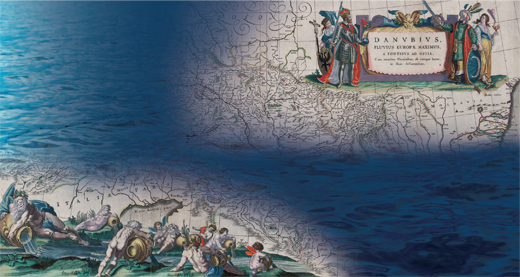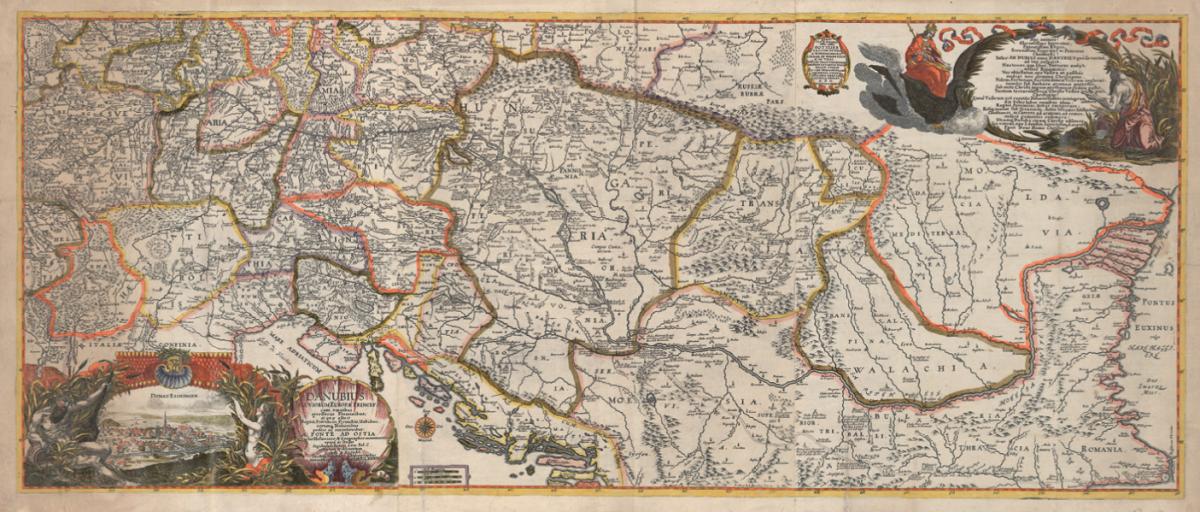
CHANGING SPACES. The Danube region on historical maps – exhibition

Since the waltz was composed by Johann Strauß, Jr., the “wonderful blue Danube” has been connected in our minds with a European region, the centers of which -- Vienna and Budapest -- were also the centers of the Habsburg Empire. This, however, has not always been the case: a major part of South-East Europe could be won for the German-Roman Emperor only at the end of the 17th century and the beginning of the 18th century, during military clashes with the Ottoman Empire. Louis William, Margrave of Baden-Baden, also known as “Türkenlouis” (Turkish Louis), who was chief commander of the Imperial army, gained military reputation in these battles. However, these unknown territories had first been displayed by the works of map makers, who thus created new regions. The River Danube was the connecting element, which connected the territories gained in the Ottoman wars into a common European region, from the origin of the river at Donaueschingen, right to its estuary flowing into the Black Sea.
The newly drawn maps of the River Danube tended to serve the legitimization of period power claims and cultural dependency relations. The enemy image formed of pagan and barbarian Turks also spread rather quickly in this way. Last but not least, it meant power for the map makers who discovered the Danube region.
The seventy precious items of the exhibition, quite a few of which will be exhibited for the first time, present the development of the cartography of the Danube region between 1650 and 1800. The exhibition is based on a rich collection of maps and landscapes that had been established by the marquises of Baden for military purposes. The exhibition is made even richer by items originating from the collection of the Institut für donauschwäbische Geschichte und Landeskunde and from the collections of private individuals.
Following the opening ceremony in Karlsruhe, the exhibition will be an international traveling exhibition, and it can be visited in several countries along the Danube region including Austria, Hungary, Romania, Serbia and Croatia. The images invite visitors to an often unknown Europe. The exhibition raises the questions to its visitors what we mean by Europe today, and by what kind of images we connect the various regions in this “common house”.
Related publications: Catalog of the exhibition entitled “Fließende Räume. Karten des Donauraums 1650–1800” (Changing Spaces. The Danube region on historical maps, 1650 1800), and a volume of essays entitled “Die späten Türkenkriege. Wahrnehmen – Wissen – Erinnern” (The Late Turkish Wars. Perception – Knowledge – Remembrance). Both books were published by Schnell & Steiner Publishing House, Regensburg, and they will be available on the site of the exhibition.
Venue: National Széchényi Library, Buda Royal Palace, Wing “F”, Ars Librorum exhibition space
Opening hours: August 2 – September 13, 2018, Tuesday to Saturday: 10.00 – 18.00
Entrance fee per person: HUF 400. Pre-arranged guided tours
More information: pr@oszk.hu
Opening ceremony of the exhibition
Facebook event
The exhibition has been set up as a joint project of the following institutions: Landesarchiv Baden-Württemberg, Institut für donauschwäbische Geschichte und Landeskunde and the Library and Information Centre of the Hungarian Academy of Sciences.
Accompanying events on the site of the exhibition
• August 31, 2018, 14.00
From Lazius’ map to Müller’s map. Maps of Hungary in the Ottoman era.
Lecture on the treasures of the Map Collection of NSZL
Dr. György Danku, researcher of NSZL
• September 1, 2018, 15.00
By ship from Vienna to Constantinople – Imperial diplomats and spies in the Early Modern Age. Lecture illustrated by the presentation of original documents
Dr. Dóra Kerekes, historian
• September 11, 2018, 16.00
World War I on Maps: Border Disputes – chamber exhibition
Opening ceremony of the chamber exhibition of NSZL’s Map Collection and a tour of the exhibition




